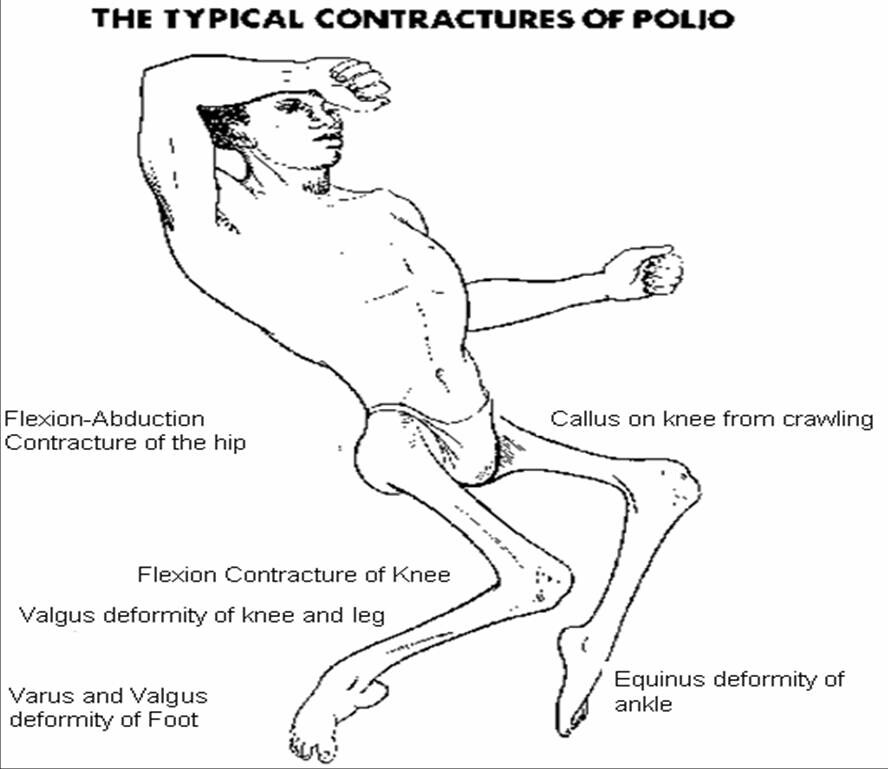-RUDDOCK.E.H,
DEFINITION-An acute infection, attacking a particularly the grey matter of the anterior horns of the spinal cord and corresponding brain areas.
This is an epidemic disease and the cause of Infantile Paralysis which remains as a sequel to it and demands prolonged treatment. Mild cases of this disease are often overlooked and only the consequent paralysis of a group or two of muscles betrays the attack. care is therefore needed not to overlook these unobtrusive ceases.
Young adults are attacks,d but the period or the first dentition (six months to two years) is much the most dangerous time.
The cause of the disease is a living organism which seems to invade the body thought the upper respiratory tract- nose and pharynx. The most important effect of the organism is on the spinal cord, although meninges and brain seldom if ever escape altogether. The cells of the grey matter of he anterior horn of the cord are more or less destroyed and the localized symptoms in. the muscles are the expression of the localized disease in the parts of he cord which are in intimate relation with those muscles.
SYMPTOMS-Usually localized paralysis and slight fever are the first symptoms to attract attention, but now and then naso- pharyngeal catarrh, fever, drowsiness, twitchings or gastro intestinal symptoms precede. Most generally groups of muscle with irregular, non-symmetrical distributions re paralyzed. The legs suffer most and it is rare for the whole of any limb to be involved. Bladder and rectum generally escape. Numbness and other sensory disturbances (seldom pain) are usual, but the motor (muscle) involvement is the striking feature.
Now and then, in epidemics, the disease will ascend throughout the cord and cause death by destroying centres respiratory for instance of in the medulla. or the centres in the medulla, affecting eyes, tongue, pharynx may be almost he only ones managed. At other times the meninges may be more involved and the symptoms may be those already described under Meningitis. Or the brain may suffer predominantly. These cases are sudden and actuate, with vomiting and convulsions and a high degree of paralysis of one side of the body (hemiplegia). It must be understood that the nerve centre attacked may be few or many and distributed irregularity so that anomalous cases are common.
After the onset there is little change for the two three weeks, and then power begins to return to q great r or less extent. Some muscles will remain permanently atrophied, but the sooner treatment is undertaken the grate the chance of limiting the permanent loss. The mortality from his disease is seldom sewer.
TREATMENT-To disinfect nose and pharynx as well as possible is wise during epidemics, as the germ grains access by this route. The disease is now notifiable.
In the acute stage Gelsemium, (especially in thereafter cases which resemble neuritis, Q.v.,a nd show pain and tenderness) is useful. Following this Phosphorous is most likely to help and Manganese, Causticum and Picric aCid. After a few days Secale, Plumbum, or stannum should be studied. the affected parts should be kept warm and at rest for th fist two weeks. After this time massage is desirable, and later electricity, Faradic if there is any response, or failing response, or, filing, response, Galvanic. FAtigue is harmful for months after the disease. As far as possible the affected muscles should be entirely relaxed. AFter a time systematic re-education of the wasted muscles does much good and although a damaged nerve centre is nerve centre is never restored,. patience and training will make much of any power that remains,and encourage other muscles to replace as far as may be ., those that are lost.
Some residual deformity is frequent and the orthopedic surgeon’s aid is often required to deal with these.
